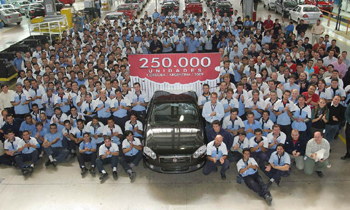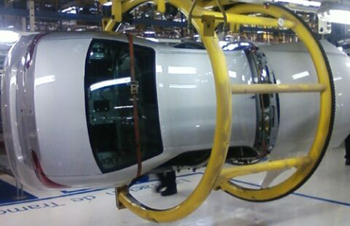 |
|
A black Fiat Siena HLX has become the
250,000 car to roll off the revived
production lines at Fiat's Industrial
Complex Ferreyra at Córdoba in Argentina,
just over a year after the 12-year-old plant
which was mothballed in the first half of
the decade resumed vehicle production. |
|
 |
|
|
|
 |
|
Having been carefully preserved the Córdoba
factory reopened in March last year with
very little work needing doing to the lines
to recommence building the Siena, operating
as a second line to ease pressure on the
Betim factory in Brazil. |
|
|
|
A
black Fiat Siena HLX has become the 250,000 car
to roll off the revived production lines at
Fiat's Industrial Complex Ferreyra at Córdoba in
Argentina, just over a year after the
12-year-old plant which was mothballed in the
first half of the decade resumed vehicle
production.
The
rejuvenated state-of-the-art Industrial Complex
Ferreyra is currently producing around 300 cars
per day for domestic sale and exporting and it
reached a total of 42,602 units in April. The
factory has the capacity to turn out 400 cars a
day. Production for the first four months of the
year is up 347 percent on the same period last
year with 2,971 units being built from January
to April in 2008 while 13,283 units have been
built so far this year. The revival of the plant
has also seen a rapid increase in the workforce
from 690 employees in 2007 to over 2,000 today.
When
the Córdoba factory first opened in 1996 it was
one of the most technologically-advanced
factories in Latin America and during the
late-1990s when the fixed peso-dollar exchange
rate provided economic stability the country's
car manufacturers were all rushing to boost
production dramatically. At the time the plant
set new standards in outsourcing, standards that
have come to be regarded as normal practice now.
Only powertrain, electronics and assembly were
then regarded by Fiat as core activities.
"We
want to outsource all but the core business that
adds value to what we produce," the Plant
Manager Massimo Risi said in 1998. "We outsource
stamping, even material handling within the
plant," he added. Suppliers entered their parts
into the final production chain just 90 minutes
before they were needed and Fiat built an
industrial park one mile away to house the
factory's suppliers. Companies then operating in
this park included Delphi, Lear and the Fiat
Group's Magneti Marelli division. The plant
assembled two members of the Project 178 "World
Car" family:
the Palio (hatchback) alongside the Siena. In
1997 the Palio hit the top of the best-sellers
in Argentina and the brand, thanks to the other
members of the 'World Car' grouping was the
biggest seller on the market.
At
it's height in the late 1990s the factory
employed 5,000 workers. However the dramatic
economic collapse that hit Argentina in 2001-02
saw production reduced to a trickle and the
plant was soon mothballed. Having been carefully
preserved it reopened in March last year with
very little work needing doing to the lines to
recommence building the Siena, operating as a
second line to ease pressure on the Betim
factory in Brazil and also take advantage of
lower wages than in Brazil. Plans to build a
one-ton pick-up on behalf of India's Tata Motors
were recently shelved while the plant also
builds engines and transmissions systems,
including gearboxes for PSA Peugeot-Citroën. The
reopening last year was part of a US$300
investment in Argentina by the Fiat Group with
the funds being shared by Fiat Powertrain
Technologies and Iveco.
Soon
Fiat Auto Argentina will hit another significant
milestone as the Fiat Siena FLP HLX which was
the 250,000th car off the production lines at
the Industrial Complex Ferreyra was also the
1,954,995th vehicle to be built in Argentina by
Fiat since manufacturing operations began. Fiat
has big ambitions for this factory and now wants
to see production raised to 600,000 vehicles a
year in 2010. The workforce will rise to 4,600
to accommodate this production increase with the
current two shifts being extended to three.
|